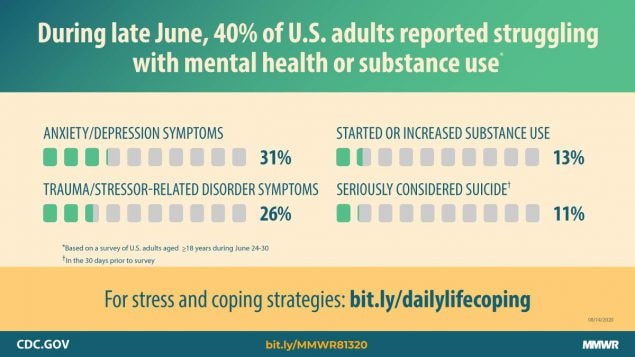Part
01
of one
Part
01
Mental Health in the US - Interesting Facts
Key Takeaways
- Lesbian, gay, or bisexual adults in the U.S. have the highest prevalence of mental illness at 47.4%.
- More than 54.7% of American adults (28 million individuals) with mental illnesses do not receive treatment.
- About 8.4 million Americans commit an average of 32 hours per week providing unpaid care to people with mental or emotional disorders.
- An estimated 7.74% of American adults in 2021 had a substance use disorder, 2.97% an illicit drug use disorder, and 5.71% an alcohol use disorder.
Introduction
This research provides 16 exciting data points about mental health in the U.S., including hyperlinks to additional information from the sources consulted and graphics illustrating the state of U.S. adult mental health. In addition to the statistics below, we have included our Research Strategy at the end of the report.
Interesting Facts About Mental Health in the U.S.
- According to John Hopkins Medicine, about 1 in 4 U.S. adults, or 26% of Americans aged 18 and above, have a diagnosable mental condition in a given year.
- The percentage of U.S. adults with serious thoughts of suicide decreased from 5.17% in 2017 to 4.66% in 2019, while in Ohio, adults with serious thoughts of suicide increased from 5.18% in 2017 to 6.09% in 2019. The national average stood at 4.58%.
- An estimated 7.74% of American adults in 2021 had a substance use disorder, 2.97% an illicit drug use disorder, and 5.71% an alcohol use disorder. Likewise, 6.34% of youths in the U.S. reported a substance use disorder in 2021, indicating that about 1.5 million youths had an illicit drug or alcohol use disorder.
- Lesbian, gay, or bisexual adults in the U.S. have the highest prevalence of mental illness at 47.4%, followed by non-Hispanic mixed/multiracial at 35.8%, non-Hispanic white at 22.6%, non-Hispanic American Indian or Alaska Native at 18.7%, Hispanic or Latino at 18.4%, non-Hispanic Black or African-American at 17.3%, non-Hispanic Native Hawaiian or Other Pacific Islander at 16.6%, and non-Hispanic Asian at 13.9%.
- Family members play a vital role in caring for a member with a mental condition. About 8.4 million Americans commit an average of 32 hours per week providing unpaid care to people with mental or emotional disorders.
- More than 54.7% of American adults (28 million individuals) with mental illnesses do not receive treatment. In Montana, about 4 in 10 adults with a mental illness did not receive care.
- Cumulatively, 28.2% of U.S. adults with a mental condition noted that they could not obtain the required treatment, while 42% of adults with AMI said they could not receive the treatment due to affordability challenges.
- Lesbian, gay, or bisexual individuals have the highest annual treatment rates among U.S. adults with any mental illness at 54.3%, followed by non-Hispanic Whites at 51.8%, non-Hispanic mixed/multiracial at 43.0%, non-Hispanic Black or African-Americans at 37.1%, Hispanic or Latino at 35.1%, and non-Hispanic Asians at 20.8%.
- Anxiety disorders affect 42.5 million adults in the U.S., 21 million Americans live with depression, PTSD (post-traumatic stress disorder) affects 12 million U.S. adults, 3.3 million U.S. adults have bipolar disorder, and 1.5 million adults have schizophrenia.
- Over 2.5 million youths, or 10.6% of youth in the U.S., cope with severe major depression. From 2021 to 2022, the number of American youths reporting severe MDE climbed by 197,000. The incidence rates are high among youth who identify with multiple races at 14.5%, equivalent to about 119,000 youths.
- Most Americans committing suicide have either a depressive disorder or substance use disorder. Research shows that “four times more men than women commit suicide.” Caucasian men over 85 have the highest suicide rates in the U.S.; however, suicide is among the causes of death in individuals aged 15 to 24.
- According to research, Generalized Anxiety Disorder (GAD) affects 6.8 million U.S. adults (3.1%), Panic Disorder (PD) affects 6 million adults or 2.7% of the U.S. population, and Social Anxiety Disorder affects 15 million U.S. adults or 7.1% of the U.S. population and starts appearing at around age 13.
- Individuals suffering from depression are 40% more likely to develop cardiovascular and metabolic diseases than healthy people. Individuals with severe mental illnesses are twice as likely to develop these diseases. In 2020, an estimated 32.1% of U.S. adults that suffered from mental disorders also had a substance use disorder.
- The unemployment rate is prevalent among U.S. adults with mental illnesses at 6.4% versus those without at 5.1%. In the education sector, students with severe depression symptoms are twice as likely to discontinue their education compared to healthy peers. Moreover, students aged 6 – 17 with behavioral, emotional, and mental disorders are three times more likely to remain/repeat the same grade.
- In 2021, about 15.08% of the youth (aged 12 – 17) suffered from at least one major depressive episode (MDE). While childhood depression can persist into adulthood if left untreated, only half of the kids with major pediatric depression are diagnosed before becoming adults. From 2021 to 2022, the number of youths with MDE increased by 306,000 (1.24%).
- An estimated 19.86% of adults, or 50 million American adults, are experiencing a mental illness, with 4.91% suffering from a severe mental illness. States leading in mental illnesses incidence rates include Ohio at 2.24%, Nebraska at 2.22%, Wyoming at 2.22%, and Oklahoma at 2.11%.
Research Strategy
For this research on interesting data points about mental health in the U.S., we leveraged the most reputable sources of information available in the public domain, including reports by national authoritative bodies like the Anxiety & Depression Association of America, CDC, Forbes, Johns Hopkins Medicine, Mental health America, National Institute
of Mental Health, National Alliance on Mental Illness, National Library of Medicine, and PubMed. For more research, the links to the sources of information and additional data and statistics are hyperlinked within the content in the form of citations.


